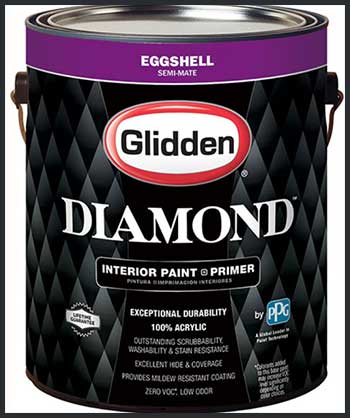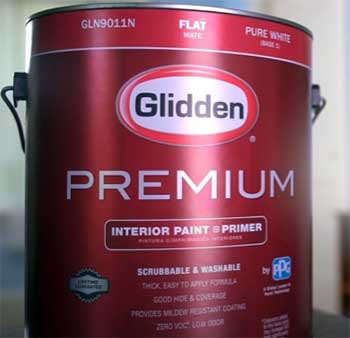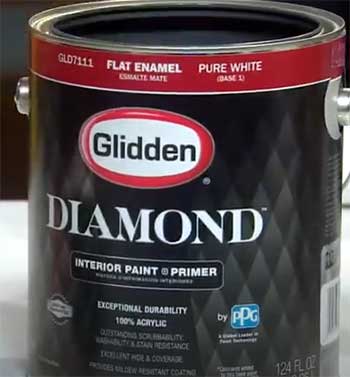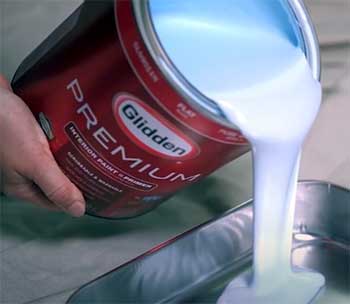I’ve painted enough rooms to know that choosing the right paint can make or break a project. Glidden Diamond and Glidden Premium are two heavyweights in the home improvement world, but which one suits your needs?
In this article, I’ll break down their key features, weigh their pros and cons, and share my firsthand insights to help you decide. Whether you’re tackling a bedroom refresh or a cabinet makeover, I’ll guide you through the differences to ensure your next painting adventure is a success.
Let’s get rolling!
A Brief Comparison Table
| Feature | Glidden Diamond | Glidden Premium |
| Price (per gallon) | $30–$40 | $20–$30 |
| Finish Options | Flat, Eggshell, Semi-Gloss | Flat, Eggshell, Semi-Gloss |
| Coverage | One-coat (in ideal conditions) | Two coats typically needed |
| Durability | High (scrub-resistant, stain-resistant) | Moderate (less scrub-resistant) |
| Application | Smooth, low splatter | Smooth, some splatter |
| Best For | High-traffic areas, cabinets, trim | Budget-friendly projects, low-traffic areas |
| VOC Content | Zero VOC | Low VOC |
| Drying Time | 1–2 hours (touch), 4–6 hours (recoat) | 2–4 hours (touch), 6–8 hours (recoat) |
| Warranty | Lifetime limited | Limited (varies by retailer) |
This table gives you a snapshot, but there’s more to unpack. Let’s explore what makes these paints tick and how they stack up in real-world scenarios.
My Experience With Glidden Diamond

When I first grabbed a can of Glidden Diamond, I was skeptical about its “one-coat” promise.
I mean, how often do paint brands actually deliver on that?
But after using it on a living room project, I was impressed.
The paint went on like a dream—thick, creamy, and with minimal drips.
I chose the eggshell finish for a subtle sheen, and it hid minor wall imperfections better than I expected.
The room was a bold navy, and with one coat, I got solid coverage, though I’ll admit, I went over a few patchy spots for peace of mind.
Glidden Diamond is marketed as a premium paint-and-primer combo, designed for durability and ease. Its zero-VOC formula means no harsh chemical smells, which was a lifesaver when I painted my kid’s bedroom with the windows barely cracked.
The paint’s scrub-resistant finish held up when my toddler decided to “decorate” the wall with crayon—a quick wipe with a damp cloth, and it was like nothing happened. This stuff is tough, making it ideal for high-traffic areas like hallways or kitchens.
But it’s not perfect. The price tag, around $30–$40 per gallon, stings a bit, especially for larger projects. And while the one-coat claim is mostly true, it depends on the surface and color. Going from a light base to a dark shade?
You might still need two coats, especially if you’re not using a sprayer. I also noticed that Diamond can feel a tad thick, which might throw off beginners who aren’t used to working with heavier paints.
Key Features of Glidden Diamond
Let’s break down what makes Glidden Diamond stand out. First, its paint-and-primer formula is a game-changer. It’s designed to stick to surfaces like a champ, whether you’re painting drywall, wood, or even glossy trim.
I’ve used it on cabinets, and the adhesion was impressive—no sanding needed in most cases, though I’d still recommend a light scuff for slick surfaces.
The zero-VOC formula is a big win for indoor projects, especially in homes with kids or pets. I painted a nursery with Diamond, and the lack of fumes meant we could use the room sooner.
The finish options—flat, eggshell, and semi-gloss—cater to different vibes, from cozy matte walls to glossy trim that pops. And that lifetime limited warranty? It’s reassuring, though I’ve never had to use it.
Durability is where Diamond shines. Its stain-resistant and scrub-resistant properties make it a go-to for busy households. I spilled coffee on a Diamond-painted wall once, and it wiped off without a trace.
The paint also resists fading, which is great for rooms with lots of sunlight. If you’re looking for a long-lasting finish, Diamond’s got you covered.
Pros And Cons of Glidden Diamond
Pros
- One-Coat Coverage (Mostly): In ideal conditions, one coat does the trick, saving time and effort.
- Top-Notch Durability: Scrub-resistant and stain-resistant, perfect for high-traffic areas or homes with kids.
- Zero VOC: No harsh smells, making it great for indoor projects and sensitive noses.
- Versatile Finishes: Flat, eggshell, and semi-gloss options suit any room or style.
- Lifetime Warranty: Adds peace of mind for long-term performance.
Cons
- Higher Price: At $30–$40 per gallon, it’s pricier than Premium, which adds up for big projects.
- Thicker Consistency: Can feel heavy for beginners, requiring a bit of finesse to avoid streaks.
- One-Coat Limitations: Dark colors or porous surfaces may still need two coats.
My Experience With Glidden Premium

Glidden Premium, on the other hand, is the budget-friendly cousin, typically priced at $20–$30 per gallon.
I used it for a guest bedroom makeover, opting for a soft gray in semi-gloss.
The application was smooth, but I noticed more splatter compared to Diamond, so I had to be extra careful with my drop cloths.
It took two solid coats to get the coverage I wanted, which wasn’t a dealbreaker but did add time to the project.
This paint is low-VOC, so the smell wasn’t overwhelming, but it wasn’t as odor-free as Diamond. I appreciated the finish options—flat, eggshell, and semi-gloss—since they match Diamond’s versatility.
However, when I tested its durability by scrubbing a scuff mark, it didn’t hold up as well. The mark faded, but I could tell the paint wasn’t as tough as Diamond. For low-traffic areas like a guest room or dining space, though, it’s a solid choice that won’t break the bank.
One downside?
The drying time felt longer. I waited about 6 hours before recoating, and even then, it felt tacky in spots. If you’re in a humid climate, you’ll need patience. Still, for the price, Premium delivers decent quality for DIYers or anyone tackling a smaller project.
Key Features of Glidden Premium
Glidden Premium is no slouch, but it’s built for value. Like Diamond, it offers flat, eggshell, and semi-gloss finishes, so you’re not sacrificing style for cost. I used the flat finish in a low-traffic office, and it gave a soft, velvety look that hid minor wall flaws.
The low-VOC formula keeps fumes in check, though you’ll notice a slight odor compared to Diamond.
Premium’s strength is its affordability. At $20–$30 per gallon, it’s a steal for covering large areas or doing multiple rooms. It’s also easy to work with, spreading evenly with a roller or brush.
However, it’s not as forgiving as Diamond on tricky surfaces like unprimed drywall or stained wood—you’ll likely need a separate primer for those.
Durability is decent but not stellar. Premium can handle light cleaning, but heavy scrubbing might wear it down over time. I wouldn’t trust it in a kid’s playroom or a busy kitchen. Still, for accent walls or spaces that don’t see much action, it gets the job done without draining your wallet.
Pros And Cons of Glidden Premium
Pros
- Budget-Friendly: At $20–$30 per gallon, it’s a cost-effective choice for large or multiple projects.
- Easy Application: Spreads smoothly, making it beginner-friendly for rollers and brushes.
- Low VOC: Minimal fumes, though not as odor-free as Diamond.
- Same Finish Options: Matches Diamond with flat, eggshell, and semi-gloss for flexibility.
Cons
- Two Coats Needed: Rarely achieves full coverage in one coat, adding time and effort.
- Less Durable: Not as scrub-resistant, so it’s less ideal for high-traffic areas.
- Longer Drying Time: Can feel tacky for up to 6–8 hours, slowing down projects.
Real-World Applications: Where Each Paint Shines?

I’ve used both paints in different scenarios, and here’s where they perform best.
Glidden Diamond is my go-to for high-traffic areas like kitchens, bathrooms, or hallways.
Its durability is unmatched—I painted a bathroom with Diamond in semi-gloss, and it’s held up to steam, splashes, and constant cleaning without a hitch.
It’s also fantastic for cabinets and trim.
I redid my kitchen cabinets with Diamond in eggshell, and the smooth, tough finish has survived daily wear and tear, from greasy fingerprints to accidental bumps.
Glidden Premium, meanwhile, is perfect for budget-conscious projects or low-traffic spaces. I used it to paint a spare bedroom and a home office, and the results were solid for the price. It’s great for accent walls, guest rooms, or spaces where durability isn’t a top concern.
If you’re a renter looking to spruce up a space without spending a fortune, Premium’s your friend. Just don’t expect it to withstand heavy scrubbing or constant abuse.
One thing to note: Diamond’s thicker formula makes it better for tricky surfaces like unprimed drywall or wood. I painted a raw wooden door with Diamond, and it adhered beautifully with minimal prep. Premium, on the other hand, struggled on a similar surface without a primer, showing streaks and uneven coverage.
Application Tips For Best Results
No matter which paint you choose, technique matters. Here’s what I’ve learned from using both:
- Prep is Key: Clean and sand surfaces for Diamond, especially on glossy trim or cabinets. For Premium, a separate primer is a must on porous or stained surfaces.
- Use Quality Tools: A good roller (3/8-inch nap for walls) and angled brush make a huge difference. I noticed less splatter with Diamond when using a high-quality roller.
- Thin Coats are Better: Even with Diamond’s one-coat claim, apply thin, even coats to avoid drips. Premium needs two coats, so plan accordingly.
- Check the Weather: Humidity slows drying for both paints, especially Premium. Aim for a dry day with good ventilation.
- Test Colors: Both paints offer color matching, but always test a small patch. I learned the hard way that a “neutral” gray can look purple in certain lighting.
Cost Vs. Value: Is Diamond Worth The Extra Cash?
Here’s where the rubber meets the road: is Glidden Diamond’s higher price worth it? For me, it depends on the project. If I’m painting a high-traffic area or something that needs to last, like cabinets or a kid’s room, Diamond’s durability and one-coat potential justify the $30–$40 per gallon.
The time saved on a second coat and the peace of mind from its toughness make it a smart investment for busy households.
But if I’m tackling a low-traffic space or a temporary refresh, Premium’s $20–$30 price tag is hard to beat. It delivers decent results for less, especially if you’re covering a large area or sticking to a tight budget.
For example, I painted a 400-square-foot living room with Premium and spent about $60 on two gallons, compared to $80–$100 for Diamond. The savings add up, but you’ll trade off some durability and ease.
Environmental Impact And Safety
As someone with kids and pets, I’m picky about paint safety. Glidden Diamond’s zero-VOC formula is a standout—no fumes, no headaches. I painted my daughter’s room during a chilly spring, and we didn’t have to air out the house for days.
Premium’s low-VOC formula is decent, but I could still smell a faint chemical odor after painting. If you’re sensitive to smells or have health concerns, Diamond’s the safer bet.
Both paints are water-based acrylics, so cleanup is a breeze with soap and water. They’re also eco-friendlier than oil-based paints, producing less waste and fewer harmful emissions. Still, Diamond’s zero-VOC edge makes it the greener choice, especially for indoor projects.
Aesthetic and Finish Options

Both paints offer flat, eggshell, and semi-gloss finishes, so you’re not limited in style.
I love Diamond’s eggshell for living rooms—it’s got just enough sheen to feel modern without being too glossy.
Semi-gloss is my pick for trim and cabinets with both paints; it’s easy to clean and adds a polished look.
Flat is great for ceilings or low-traffic walls, but Premium’s flat finish showed scuffs faster than Diamond’s.
Color selection is identical for both, with thousands of shades available at Home Depot. I’ve used their color-matching service for both paints, and it’s spot-on, whether you’re matching a fabric swatch or a competitor’s shade.
Just keep in mind that darker colors with Premium often need an extra coat for true opacity.
Performance in Different Climates
Living in a humid area, I’ve seen how weather affects paint. Diamond dries faster and resists moisture better, making it ideal for bathrooms or coastal homes. I painted a porch with Diamond semi-gloss, and it’s held up to rain and humidity without peeling.
Premium, however, took longer to cure in humid conditions, and I noticed some tackiness even after 8 hours. If you’re in a dry climate, Premium’s drying time might not be an issue, but for damp areas, Diamond’s the better pick.
Long-Term Maintenance
Maintaining painted surfaces is where Diamond pulls ahead. Its scrub-resistant finish means you can clean walls without worrying about fading or damage. I’ve scrubbed spaghetti sauce off a Diamond-painted kitchen wall with no issues.
Premium’s less forgiving—light cleaning is fine, but aggressive scrubbing can dull the finish or remove paint. For spaces that need frequent touch-ups, like a mudroom, Diamond’s durability saves you repainting headaches.
Choosing The Right Paint For Your Project
So, how do you choose?
Here’s my rule of thumb: go with Glidden Diamond if you’re painting high-traffic areas, cabinets, or trim where durability and ease matter most. Its one-coat potential and tough finish make it worth the extra cost for spaces that see daily wear.
Choose Glidden Premium if you’re on a budget or painting low-traffic areas like guest rooms or accent walls. It’s a solid performer for the price, but expect to invest more time in application and touch-ups.
I recently helped a friend decide between the two for her home. She went with Diamond for her kitchen and bathrooms for the durability and Premium for her bedrooms to save cash.
The combo worked beautifully—her kitchen walls still look pristine after a year, and the bedrooms have held up fine with minimal wear.
Frequently Asked Questions (FAQ)
Yes, in ideal conditions—like light colors over primed surfaces. Dark shades or porous walls may need two coats.
Absolutely. Its durable, scrub-resistant finish and strong adhesion make it excellent for cabinets, especially in semi-gloss.
Yes, it’s a solid budget option for low-traffic areas, offering decent coverage and easy application.
It’s a low-VOC, water-based acrylic paint, available in flat, eggshell, and semi-gloss finishes.
Conclusion: Your Paint, Your Choice
You’ve got a project in mind, and now you know the scoop on Glidden Diamond and Glidden Premium. I’ve shared my experiences to help you pick the paint that fits your needs, whether you’re after Diamond’s tough, one-coat magic or Premium’s wallet-friendly reliability.
Think about your space, your budget, and how much wear your walls will take. Whichever you choose, you’re on your way to a fresh, vibrant home. So grab a roller, pick your shade, and make those walls yours!
